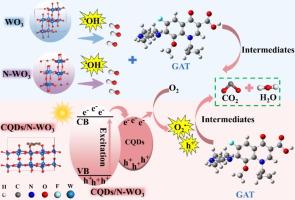协同掺杂和负载策略修饰WO3纳米花,通过活性氧调控有效光催化降解抗生素
IF 9
1区 工程技术
Q1 ENGINEERING, CHEMICAL
引用次数: 0
摘要
开发一种高效、强效的光催化剂对其在水处理领域的实际应用具有重要意义,如去除水中新出现的污染物。本文通过氮掺杂和碳量子点(CQDs)负载在WO3纳米花上的协同策略,设计了碳量子点/N-WO3纳米花,该纳米花由于其调制的电子结构而具有优异的光催化性能。实验表征和理论计算均证实了协同效应加速了O2p向W5d的电子转移能力,从而由于W5d轨道电子密度的增加而提高了光生电子和空穴分离效率。在模拟太阳光照下,最佳光催化剂在60 min内反应速率常数(k1)为0.055 min−1,对加替沙星(GAT)的去除率达到100% %。此外,淬火实验和自由基检测表明,GAT去除的主要活性氧(ROS)由•OH (WO3和N-WO3)转变为O2•−(CQDs/N-WO3)。基于Fukui指数的密度泛函理论(DFT)计算进一步表明GAT的反应位点可被亲电攻击。WO3上掺杂N和CQDs后,其带隙缩小,可见光利用率提高。此外,N位的高电子密度更有利于空穴捕获,CQDs作为电子受体和传递体增强了电子传递。掺杂和负载的协同策略为调节催化剂的电子结构开辟了新的视角,并为调节类芬顿反应中的ROS类型以去除水中新出现的污染物提供了参考。本文章由计算机程序翻译,如有差异,请以英文原文为准。

Synergistic doped and loaded strategies to modify WO3 nanoflowers for efficient photocatalytic degradation of antibiotics through reactive oxygen species regulation
Developing an effective and powerful photocatalyst is important to its practical application in water treatment area, like emerging contaminants removal in water. Herein, through a synergistic strategy of N-doping and carbon quantum dots (CQDs)-loading on WO3 nanoflowers, CQDs/N-WO3 was designed, which exhibited excellent photocatalytic performance due to modulated electronic structure. Both experimental characterization and theoretical calculation confirmed that the synergistic effect accelerated the electron transfer ability from O2p to W5d, thus promoting the photogenerated electron and hole separation efficiency owing to the increased W5d orbital electron density. The optimum photocatalyst achieved 100 % removal of gatifloxacin (GAT) with a high reaction rate constant (k1) of 0.055 min−1 in 60 min under simulated solar light. Moreover, quenching experiment and radical detection demonstrated that the main reactive oxygen species (ROS) changed from •OH (WO3 and N-WO3) to O2•− (CQDs/N-WO3) for GAT removal. Density functional theory (DFT) calculation based on Fukui index further indicated the reactive sites of GAT were available for electrophilic attack. The internal mechanism was also deduced that after N doped and CQDs loaded on WO3, narrowed band gap and increased utilization of visible light were observed. Moreover, the high electron density of N sites was more conducive to hole capture, and CQDs enhanced the electron transport as electron acceptor and transporter. The synergistic strategy of doping and loading opens a new perspective for modulating the electronic structure of catalysts, and provides a reference for regulating the ROS types in Fenton-like reactions for the removal of emerging contaminants in water.
求助全文
通过发布文献求助,成功后即可免费获取论文全文。
去求助
来源期刊

Separation and Purification Technology
工程技术-工程:化工
CiteScore
14.00
自引率
12.80%
发文量
2347
审稿时长
43 days
期刊介绍:
Separation and Purification Technology is a premier journal committed to sharing innovative methods for separation and purification in chemical and environmental engineering, encompassing both homogeneous solutions and heterogeneous mixtures. Our scope includes the separation and/or purification of liquids, vapors, and gases, as well as carbon capture and separation techniques. However, it's important to note that methods solely intended for analytical purposes are not within the scope of the journal. Additionally, disciplines such as soil science, polymer science, and metallurgy fall outside the purview of Separation and Purification Technology. Join us in advancing the field of separation and purification methods for sustainable solutions in chemical and environmental engineering.
 求助内容:
求助内容: 应助结果提醒方式:
应助结果提醒方式:


